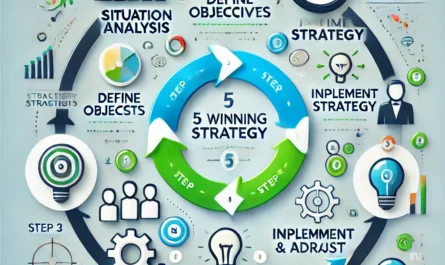Businesses today must stay ahead of the competition by harnessing the power of technology. With the right strategies, companies can leverage technology to enhance efficiency, drive innovation, and fuel sustainable growth. In this article, we will explore five proven strategies to use technology for business innovation and growth that can significantly boost your company’s success.
Technology has become an indispensable tool for organizations looking to scale their operations and innovate continuously. Whether it’s improving internal processes, optimizing customer experiences, or developing new products, technology offers endless possibilities for growth. But how do businesses make the most of it? Here are five key strategies you can adopt.
Embracing Cloud Technology for Flexibility and Scalability
Cloud computing has revolutionized how businesses operate by offering unparalleled flexibility and scalability. In today’s fast-paced environment, businesses need to adapt quickly to changing demands. Cloud solutions enable organizations to scale up or down their IT resources on demand, ensuring that they only pay for what they use. This scalability is especially beneficial for growing businesses that require additional resources without significant upfront costs.
Moreover, cloud technology promotes collaboration by allowing employees to access information and work from anywhere, enhancing productivity and reducing the need for physical infrastructure. Whether you’re using cloud-based storage, software as a service (SaaS), or platform as a service (PaaS), the cloud enables innovation by freeing up resources to focus on core business activities.
Adopting cloud technology also improves business continuity by providing secure backups and reducing the risk of data loss. As businesses increasingly rely on data, having a reliable cloud backup solution ensures that critical information is always protected.
Key Benefits of Cloud Technology
- Cost-effective scalability
- Enhanced collaboration and remote work capabilities
- Improved security and data protection
- Access to cutting-edge technologies without large capital investment
Implementing Artificial Intelligence (AI) for Data-Driven Decision Making
Artificial intelligence (AI) is no longer a futuristic concept; it’s a game-changer in today’s business world. AI enables companies to analyze vast amounts of data, uncovering patterns and insights that were previously unattainable. By leveraging AI tools, businesses can make data-driven decisions that improve efficiency, customer experiences, and overall performance.
For example, AI can be used to automate routine tasks, allowing employees to focus on more strategic initiatives. AI-driven chatbots, for instance, enhance customer service by providing instant responses and personalized recommendations, improving customer satisfaction and reducing response times.
In addition to customer service, AI has a significant impact on marketing. Predictive analytics powered by AI allows businesses to forecast trends, optimize pricing strategies, and personalize marketing campaigns. This level of personalization leads to better customer engagement, higher conversion rates, and ultimately, greater business growth.
AI is also transforming industries such as healthcare, finance, and manufacturing by enabling innovations like smart diagnostics, fraud detection, and predictive maintenance.
Key Applications of AI in Business
- Enhanced customer service through AI-driven chatbots
- Predictive analytics for marketing and sales optimization
- Automation of repetitive tasks, improving operational efficiency
- Innovations in product development and service delivery
Leveraging Big Data Analytics to Understand Customer Behavior
Big data is a valuable resource for businesses looking to gain insights into customer preferences, behaviors, and trends. By analyzing large volumes of data from multiple sources, businesses can identify patterns that inform decision-making processes. These insights enable companies to develop more targeted marketing strategies, optimize supply chains, and improve product offerings.
One of the most significant advantages of big data analytics is the ability to personalize the customer experience. By understanding individual customer preferences, businesses can offer tailored solutions, products, and services, leading to increased customer loyalty and higher lifetime value.
Moreover, big data analytics allows businesses to optimize their operations by identifying inefficiencies and areas for improvement. By tracking key performance indicators (KPIs), businesses can make data-driven adjustments that lead to cost savings and improved productivity.
Using big data analytics also opens up opportunities for innovation. By identifying emerging trends and customer needs, businesses can develop new products or services that cater to these demands, staying ahead of the competition.
Key Benefits of Big Data Analytics
- Deeper understanding of customer preferences and behaviors
- Ability to personalize products and services
- Improved decision-making through data-driven insights
- Enhanced operational efficiency and cost optimization
Integrating Automation Tools to Streamline Business Processes
Automation is a powerful strategy for businesses looking to enhance efficiency and reduce operational costs. By automating repetitive and time-consuming tasks, businesses can free up valuable resources, allowing employees to focus on more strategic activities. Automation tools can be applied to various aspects of a business, from marketing and sales to HR and finance.
For example, marketing automation platforms enable businesses to streamline their campaigns by automating tasks such as email marketing, social media posting, and lead nurturing. This not only saves time but also ensures that campaigns are delivered consistently and at the right time to the target audience.
In HR, automation tools can be used to handle tasks such as payroll processing, employee onboarding, and performance evaluations. This reduces the administrative burden on HR teams and ensures that processes are completed accurately and efficiently.
Automation also plays a crucial role in supply chain management. By automating inventory tracking, order processing, and logistics, businesses can minimize errors, reduce lead times, and improve overall supply chain performance.
Key Advantages of Automation in Business
- Increased efficiency and reduced operational costs
- Consistency in marketing and sales efforts
- Enhanced accuracy in HR and finance processes
- Improved supply chain management and logistics
Fostering Innovation with Digital Transformation Strategies
Digital transformation is the process of integrating digital technologies into every aspect of a business, fundamentally changing how organizations operate and deliver value to customers. While technology is at the core of digital transformation, it also requires a shift in culture and mindset to embrace innovation and change.
Successful digital transformation strategies focus on enhancing customer experiences, optimizing business processes, and driving continuous innovation. This involves adopting technologies such as cloud computing, AI, IoT (Internet of Things), and mobile solutions to create a seamless and connected business environment.
One of the key drivers of digital transformation is customer experience. Businesses that prioritize delivering a seamless, personalized experience across all touchpoints are more likely to retain customers and gain a competitive advantage. For example, using AI and big data analytics to understand customer needs allows businesses to offer more relevant products and services.
Digital transformation also enables businesses to be more agile, responding quickly to changes in the market and customer expectations. This flexibility is critical for staying ahead in today’s fast-paced business landscape.
You can also read; Master Financial Forecasting to Build a Stronger Business Strategy
Key Elements of a Successful Digital Transformation
- Embracing a customer-centric approach
- Leveraging emerging technologies such as AI, IoT, and cloud computing
- Cultivating a culture of innovation and continuous improvement
- Enhancing agility and responsiveness to market changes



